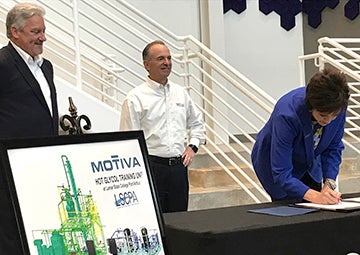Labor market: Ups and downs in Jefferson County
Published 12:40 pm Thursday, February 21, 2019

- Lamar State College Port Arthur President Betty Reynard, right, signs an agreement connected to a $250,000 gift from Motiva for a work training unit at the LSCPA. The workforce training gift was made Jan. 22 at the college. Ken Stickney, Port Arthur News
AUSTIN — The Beaumont/Port Arthur area is facing economic- and workforce-related challenges but there is light at the end on the tunnel.
Mariana Vega, Texas Workforce Commission’s director of labor market and career information department, shed light on the good, bad and the ugly of the local labor market during a Golden Triangle Days presentation in Austin last week.
Unemployment rate
Texas has, since 2007, had a lower unemployment rate than the U.S. up until 2016 and since then the rates have gone wavered. But the Beaumont/Port Arthur Metropolitan Statistical Area has been consistently higher than the state and the U.S.
The local jobless rate currently stands at 5.8 percent. Vega acknowledged the area has survived natural disasters such as hurricanes, which greatly affect the rate, as well as recent layoffs, which contributed a slight increase. This number is well below the high of 11.7 percent in 2010.
But the unemployment rate is tied to another important figure — the poverty level.
“Port Arthur does have the highest unemployment rate (when looking at cities within the county) which does contribute to the poverty level so that the area has a poverty level that is 37 times higher than the national average,” she said.
Hardin and Chambers counties have lower unemployment rates at 4.9 percent.
Employment growth
A slowdown in the oil and gas industry in 2015-2016 led to a slight dip in the economy that was further affected by Hurricane and Tropical Storm Harvey in 2017.
The growth at that time was a negative 2.8 percent, though there was an uptrend until September 2018. The growth rate currently stands at negative .6 percent.
The employment growth came from the fields of transportation, warehouse and utilities that added an additional 400 jobs, she said. Mining, logging and construction saw the addition of 800 jobs while professional business and services are also showing a strong growth.
Wages
“What we are seeing is that Beaumont and Port Arthur has some of the highest total weekly wages even in comparison to other metro areas in terms of average wages,” she said. “The annual average wage of the Beaumont/Port Arthur area stands at $47,900, which is right below the state average.”
Wages are a regional issue. The area offers some of the highest average wages for engineering technicians at over $73,000 per year for jobs that typically need only an associate’s degree.
Statewide, engineering technician jobs are expected to grow by almost 15 percent.
The future
From now until 2026, the state is expected to see a 12 percent job growth, some of which is tied to population. And over 30 percent of the jobs will require some post-secondary education and training.
Jobs in science, technology, engineering and math related careers are expected to grow while the information industry — newspaper and book publishing — is expected to decline.
Population
“The Hispanic population is expected to double by 2050, a trend that we are also seeing across the state,” she said. “So, in the Beaumont/Port Arthur area that would bring the total to over 109,000. We’re seeing the same situation with the Asian population. The black and white populations are actually expected to decrease a little it.”
Vega brought up the statistics on race because the Hispanic population group lags behind as far as educational attainment. There was an 8 percent increase in high school completion and a 3 percent increase in bachelor’s degree completion, though.
Wanted: work
A skills gap often prevents people from working. Hard skills, such as degrees or certifications, are easier to attain and measure then soft skills such as teamwork, good communication skills and organizational skills.
“A lot of times what is keeping someone from getting a good job with livable wages is not that they don’t want to work. It has to do more with a skills gap,” she said.
Programs
TWC offers job training programs for both businesses and workers with the goal of increasing people skills as well as increasing people’s wages:
- Skills Development Fund, which worked with DuPont and Firestone Polymers in a partnership with Lamar State College to train workers.
- Self Sufficiency Fund, which is aimed at helping those on Temporary Assistance for Needy Families and Supplemental Nutrition Assistance Program that earn less than $37,000 with a dependent or those at risk of being below the poverty level to receive skills in industry recognized certifications.





